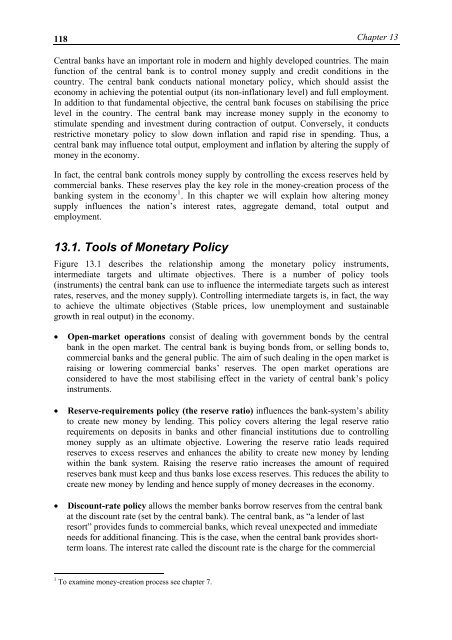MacroeconomicsI_working_version (1)
You also want an ePaper? Increase the reach of your titles
YUMPU automatically turns print PDFs into web optimized ePapers that Google loves.
118<br />
Chapter 13<br />
Central banks have an important role in modern and highly developed countries. The main<br />
function of the central bank is to control money supply and credit conditions in the<br />
country. The central bank conducts national monetary policy, which should assist the<br />
economy in achieving the potential output (its non-inflationary level) and full employment.<br />
In addition to that fundamental objective, the central bank focuses on stabilising the price<br />
level in the country. The central bank may increase money supply in the economy to<br />
stimulate spending and investment during contraction of output. Conversely, it conducts<br />
restrictive monetary policy to slow down inflation and rapid rise in spending. Thus, a<br />
central bank may influence total output, employment and inflation by altering the supply of<br />
money in the economy.<br />
In fact, the central bank controls money supply by controlling the excess reserves held by<br />
commercial banks. These reserves play the key role in the money-creation process of the<br />
banking system in the economy 1 . In this chapter we will explain how altering money<br />
supply influences the nation’s interest rates, aggregate demand, total output and<br />
employment.<br />
13.1. Tools of Monetary Policy<br />
Figure 13.1 describes the relationship among the monetary policy instruments,<br />
intermediate targets and ultimate objectives. There is a number of policy tools<br />
(instruments) the central bank can use to influence the intermediate targets such as interest<br />
rates, reserves, and the money supply). Controlling intermediate targets is, in fact, the way<br />
to achieve the ultimate objectives (Stable prices, low unemployment and sustainable<br />
growth in real output) in the economy.<br />
• Open-market operations consist of dealing with government bonds by the central<br />
bank in the open market. The central bank is buying bonds from, or selling bonds to,<br />
commercial banks and the general public. The aim of such dealing in the open market is<br />
raising or lowering commercial banks’ reserves. The open market operations are<br />
considered to have the most stabilising effect in the variety of central bank’s policy<br />
instruments.<br />
• Reserve-requirements policy (the reserve ratio) influences the bank-system’s ability<br />
to create new money by lending. This policy covers altering the legal reserve ratio<br />
requirements on deposits in banks and other financial institutions due to controlling<br />
money supply as an ultimate objective. Lowering the reserve ratio leads required<br />
reserves to excess reserves and enhances the ability to create new money by lending<br />
within the bank system. Raising the reserve ratio increases the amount of required<br />
reserves bank must keep and thus banks lose excess reserves. This reduces the ability to<br />
create new money by lending and hence supply of money decreases in the economy.<br />
• Discount-rate policy allows the member banks borrow reserves from the central bank<br />
at the discount rate (set by the central bank). The central bank, as “a lender of last<br />
resort” provides funds to commercial banks, which reveal unexpected and immediate<br />
needs for additional financing. This is the case, when the central bank provides shortterm<br />
loans. The interest rate called the discount rate is the charge for the commercial<br />
1 To examine money-creation process see chapter 7.




